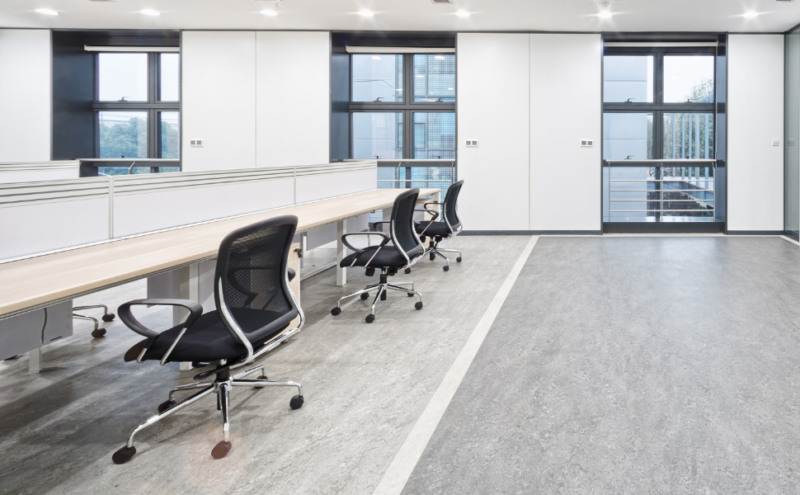 By Ashley Cascio, Climatec Director of Energy Services
By Ashley Cascio, Climatec Director of Energy Services
It has been a year since the world stopped spinning. As public health experts raced to beat the coronavirus, everyone adapted to a new way of life. Those leading local governments and schools closed facilities, migrated classes and programs online and waited along with their constituents.
Now, a vaccine is being distributed and the world is slowly and hesitantly resuming. Both the private and public sectors are exploring ways to safely reopen their doors to stakeholders. Local governments and schools are uniquely positioned to set a good example by reopening “right,” though they balance this with both the risks of the pandemic and state crackdowns.
A holistic, sustainable approach is necessary to prevent viral transmission. In the early days of the pandemic, public agencies quickly added personal protective equipment, plexiglass, thermometers, hand sanitizing stations and one-way entrances and exits to facilities. Now more organizations are improving indoor air quality as a long-term solution.
How the Coronavirus Stays Alive
The Environmental Protection Agency defines indoor air quality, or IAQ, as the air quality within and around buildings and structures, especially as it relates to the health and comfort of building occupants. Technology and environmental specialists have always factored pollutants, allergens, viruses, bacteria and other harmful airborne particles into IAQ. With wildfire smoke trailing close behind, SARS-CoV-2 (COVID-19) is now the leader on the list of threats in our air.
Coronavirus particles thrive in indoor spaces that trap air. Without proper ventilation and air purification, the virus can float for longer periods of time, making its way around a room until it lands on a surface or finds a new host.
Agencies can add new infrastructure or they can retrofit existing infrastructure to clean the air in indoor spaces. These solutions appear to be a golden ticket to long-term reopening and a return to normalcy. Moreover, the benefits of using such technologies surpass the pandemic by relieving typical pressures on agency budgets as well as by positively impacting health, productivity and comfort for occupants.
What Works? A Recap of “COVID-Killing” Technologies on the Market
Miracle products have made their way to the market with claims of being the next best solution for killing COVID-19. However, only a fraction have been cleared by authorities, such as the Centers for Disease Control and Prevention (CDC) or the American Society of Heating, Refrigerating and Air-Conditioning Engineers (ASHRAE).
Being a part of Bosch, a $94 billion global engineering and technology company that focuses on research and development, Climatec gets access to the technologies with a demonstrated record of deactivating the coronavirus and purifying indoor air. Climatec can provide solutions to help combat COVID-19, starting with heating, ventilation and air conditioning (HVAC) technologies, which have the greatest capacity to be COVID-fighting machines.
MERV 13 Filters
HVAC units can contain filters of various MERV ratings, which are determined by an ASHRAE testing method. For advanced filtration that captures coronavirus particles and clusters, both the CDC and ASHRAE recommend filters that have a grade of MERV 13 or better. MERV 13 filters trap 90 percent of particles within 3-10 microns, 85 percent of particles within 1-3 microns and 50 percent of particles within 0.3-1 micron. Both coronavirus and smoke particles are about or less than 0.1 micron.
MERV 13 filters don’t seize individual coronavirus particles. They capture those that magnetize to other particles as they move throughout a room. This clustering phenomenon is enhanced by ionization technology, another HVAC application.
Needlepoint Bipolar Ionization
Bipolar ionization is nature’s way of cleaning outdoor air. When bipolar ionization is underway, negative and positive ions latch onto substances of the opposite charge, deactivating them or attracting more ions to form larger particle clusters. Scientists have managed to replicate nature’s air-purifying process in needlepoint bipolar ionization (NPBI) applications for HVAC systems.
Just as positive and negative ions are produced when a wave crashes ashore, they’re created as contaminated air passes the NPBI tubes of an HVAC unit. While some pathogens will deactivate, others will clump to the ions to form clusters of 0.3 microns or larger. As they make their way through the HVAC, these clusters get caught in the MERV 13 filter.
O2 Prime and GPS, NPBI providers vetted by Climatec and Bosch, confirmed the efficacy of ionization on airborne pathogens with thorough independent testing. Innovative BioAnalysis, an independent testing agency certified by the State of California, College of American Pathologists, Clinical Laboratory Improvement Amendments and AABB, provides an August 2020 study that finds NPBI 99.8 percent effective at deactivating COVID-19.
Based on this research as well as that conducted by our own PhD team, Climatec recommends NPBI as the best air purification solution available on the market today. In addition to school districts and cities, Climatec has implemented NPBI for Phoenix International Airport and Banner hospitals throughout Arizona.
But Climatec clients aren’t the only authorities implementing NPBI. Aviation and healthcare industries across the country, including Los Angeles International, Chicago O’Hare International, San Francisco International and LaGuardia airports, Mayo Clinic and scores of other hospitals are also rolling out the technology. These organizations are in good company with the White House, Harvard University and Google, who also added NPBI during the pandemic.
Economizers
Economizers are another HVAC modernization that reduces the amount of airborne pathogens in indoor spaces. They work by drawing outdoor air inside and exhausting indoor air outside. The mechanism keeps stale, contaminated air from recirculating while simultaneously diluting rooms with fresh air.
HVAC System Upgrades
A modernized HVAC unit is the foundation for MERV 13 filters, NPBI and economizers. While some public agencies have HVAC systems that can be retrofitted with these enhancements, others deal with antiquated infrastructure that needs to be replaced first. After all, the U.S. Government of Accountability Office reported that approximately 54 percent of school districts nationwide need to update or replace multiple building systems–41 percent of which need to replace HVAC systems in at least half of their schools.
Ultraviolet (UV) Radiation
UV radiation works by destroying the outer protein case of the coronavirus, thereby deactivating it. UV technology must have direct exposure; high dosage; and be used for a sufficient duration to work. If a UV application misses one or more of these factors, then it will not be effective. Even when a UV application checks the boxes on exposure, dose and duration, it doesn’t mean it is time or cost-effective.
UV-C Lamps
UV-C lamps are not cost-effective because they demand being operated for a significant time, thus increasing energy demand.
Because UV radiation is toxic to humans, UV-C lamps cannot run in occupied facilities. The technology should only be used in vacant rooms, often overnight since they require hours of exposure to deactivate the coronavirus. Also consider that the large amounts of energy required to run UV-C lights will eventually make its way to your utility bill.
UV in HVACs
According to whitepapers, HVAC units with UV light installations are not foolproof. This is because air simply moves too quickly through the unit for the UV lights to have enough direct exposure to disinfect the air or effectively combat any and all airborne viruses and bacteria.
Portable UV Lamps
Portable UV lamps offer the benefits of UV without as many of the drawbacks. They work on a much smaller scale and are best used to disinfect high-touch surfaces, such as bus rails, countertops and door handles.
Portable HEPA Filters
Airlines and hospitals alike are using high-efficiency particulate air (HEPA) filters to combat COVID–and for good reason. HEPA filters offer the benefits of MERV 13 filters but with portability. They are particularly useful in high-traffic areas or facilities lacking modernized HVAC technology.
There Hasn’t Been a Better Time to Renew Infrastructure
Clean air improvements do more than just protect and support public health. They often provide net budget relief, reduce greenhouse gas emissions and create independence from utility providers.
Cost Savings
After replacing or retrofitting antiquated infrastructure, equipment becomes more efficient, requiring less maintenance and energy.
Energy efficiency is made possible by smart technology, such as building automation systems (BAS) and economizer controls in an HVAC system. BAS are temperature controls that communicate with an HVAC system to steady room temperatures while using as little energy as possible. HVAC economizer controls draw on natural resources by bringing in cool air when environmental conditions are good. This requires your HVAC system to use less energy to produce cool air. Pairing economizer controls and BAS with other energy-efficient or renewable energy infrastructure can result in hundreds of thousands of dollars staying in your general fund.
Comprehensive infrastructure programs are more cost effective than one-off improvements. Adding HVACs with ionization technology citywide may provide greater net budget relief than adding a few units to high-traffic sites. Pairing mass HVAC modernizations with highly efficient LED lights and smart irrigation controls can result in even more savings.
For example, the City of Ontario recently approved an infrastructure renewal program that calls for power resiliency, air quality, energy efficiency and smart city technologies citywide. Over the 30-year lifespan of the equipment, the City will save more than $75 million in taxpayer dollars, a combination of about $56 million in operational savings and $19 million in capital expenditure savings. Ontario’s savings surpass the cost of its entire program plus any loan repayments.
Just a month before the City of Ontario approved its program, the Culver City Unified School District approved a clean air program: a second phase of infrastructure improvements consisting entirely of clean air measures. The Culver City Unified program adds new HVAC economizers, ionization technology, MERV 13 filters and portable UV-C lights that will save the district more than $5 million.
Resiliency
California governments are not just battling the pandemic. They are also dealing with long wildfire seasons, a distressed economy and public animosity. Every resource counts.
Energy hungry infrastructure that’s far past useful life is making its way to most agencies’ utility bills and detracting from their budgets. Plus, California utility companies have been increasing rates while becoming less reliable. Worse yet, PSPS threatens city and school district operations under wildfire conditions.
Resiliency infrastructure helps agencies tackle these challenges. Solar technology, backup generators and battery storage are becoming the most sought-after means of keeping critical facilities running during heat waves, wildfires and the pandemic.
Konocti Unified School District in Lower Lake, CA was trapped between the LNU Lightning Complex and August Complex Fires. During the fires, Konocti’s board of trustees approved an $8.5 million infrastructure program that addresses power shutoffs, blackouts, indoor air quality and rising utility costs. Leveraging HVAC modernizations, portable HEPA filters, solar technology and backup generators, the district will be able to stay online year-round. Konocti USD projects about $19 million in general fund relief over the next 30 years.
Available Funding Opportunities
Federal, state and regional funding is available for energy infrastructure programs. Public agencies can also leverage utility incentives, private capital, and if available, capital budget. Furthermore, agencies can combine different funding sources for their programs.
For example, over the past seven years of partnership with Climatec and three phases of improvements, the City of San Leandro has used a range of funding: utility incentives, a grant from the California Energy Commission and private sector funding at extremely low interest rates. Since, San Leandro has gained approximately $23 million in general fund relief while achieving stature as an award-winning, globally recognized leader in smart city technology.
San Leandro, Ontario, Konocti USD and Culver City USD aren’t the only agencies forging ahead despite pandemic setbacks. For many, renewing energy infrastructure is the first step in resuming life better and stronger.

